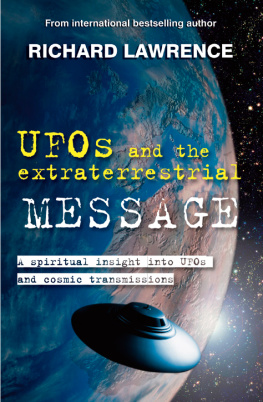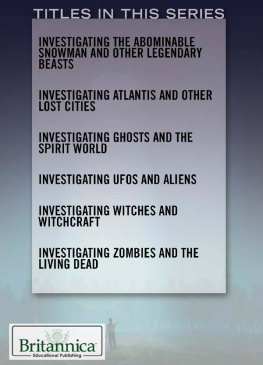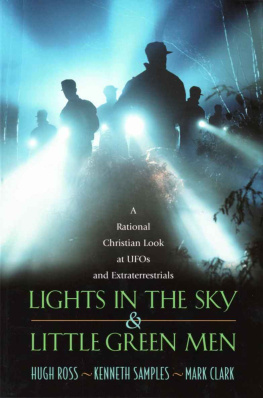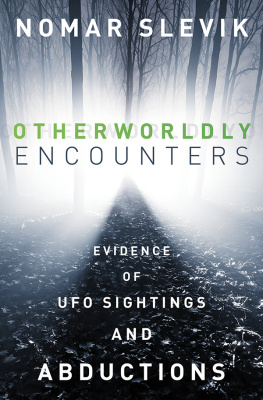Moroney's detailed and rich self-analysis of his own contact experience is unique among such literature. His analysis of the UFO abduction scenario raises many questions, and he makes observations and comments that challenge traditional views within not only ufology, but our society and view of ourselves in the universe. Whether or not we believe such experiences are real, the contactee phenomenon, as opposed to the abductee phenomenon, as laid out in Moroney's work, deserves consideration. The spiritual component of the contactee experience is something that must be addressed, and Moroney's reasoning why this is so supports this viewpoint.
CHRIS RUTKOWSKI
science writer and
author of A World of UFOs
Copyright 2009
by Jim Moroney
All rights reserved, including the right to reproduce this work in any form whatsoever, without permission in writing from the publisher, except for brief passages in connection with a review.
Cover design by Steve Amarillo
Cover art by Jeff Vanuga/Corbis
Illustrations by Ralph Hagen
www.hagenstoons.com
www.aufosg.com
Hampton Roads Publishing Company, Inc.
Charlottesville, VA 22906
www.hrpub.com
Library of Congress Cataloging-in-Publication Data
Moroney, Jim, 1960
The extraterrestrial answer book : UFOs, alien abductions, and the coming ET presence / Jim Moroney.
p. cm.
Summary: We are not alone. Covering topics from the scientific evidence that aliens exist to what the government should do about them to why they are here in the first place, this book provides specific instructions on how to handle an extraterrestrial encounterProvided by publisher.
Includes bibliographical references and index.
ISBN 978-1-57174-620-7 (5.25 7.25 tp : alk. paper)
1. Human-alien encounters. I. Title.
BF2050.M663 2009
001.942--dc22
2009032967
ISBN 978-1-57174-620-7
10 9 8 7 6 5 4 3 2 1
Printed on acid-free paper in the United States
www.redwheelweiser.com
www.redwheelweiser.com/newsletter
To all those I love (you know who you are).
TABLE OF CONTENTS
CHAPTER ONE
Through the Looking Glass
CHAPTER TWO
Overview of Proof
CHAPTER THREE
Intervention
CHAPTER FOUR
What's Happening?
CHAPTER FIVE
What's Their Goal?
CHAPTER SIX
Spirituality
CHAPTER SEVEN
Government
CHAPTER EIGHT
Science
CHAPTER NINE
For Contactees: Assimilating
CHAPTER TEN
What Can Ordinary People Do?
CHAPTER ELEVEN
Summary and Wrap-Up
APPENDIX A
Websites and Recommended Reading
APPENDIX B
Premonition
FOREWORD
Sometimes I think we're alone in the universe, and sometimes I think we're not. In either case the idea is quite staggering.
Arthur C. Clarke, author of 2001: A Space Odyssey
Just about the only thing I can say with certainty about the aliens is that they come from a very different world from ours. It's a world so fundamentally different that I'm not sure we'll ever fully understand them or their purposes. Sobering as that thought may be, I'm still convinced that we must at least try to understand them and meet them halfway. Our future and the future of this planet likely depend on it.
So far, our collective response to their existence has been abysmal at best. This must change.
There are two main types of interaction between the aliens and humans. The first type of interaction involves visual sightings of unidentified flying objects (UFOs) or the physical traces they leave behind. The second type of interaction involves direct contact, sometimes including the abduction of one or more human beings. While the aliens may have a rather casual attitude regarding who sees their craft, their attitude towards human contact is anything but casual. Not only do they appear to be very deliberate about their choice of contactees, they're quite careful to control what each contactee remembers, and the timing under which these memories are allowed to surface.
For whatever reason, I'm one of the millions of people world wide who have been contacted. This contact has presented some of the greatest emotional, intellectual, and spiritual challenges of my life. In spite of that, I do not feel as if I've been a victim. Since 1987, I've immersed myself in the study, understanding, and, ultimately, the acceptance of this great mystery. This book is the result of my personal struggle and journey into a greater reality that all of us will have to face eventually.
Even after twenty years, it is still a struggle and the journey is nowhere near its end. To ponder the question of whether or not other living beings exist is one thing; to know that they exist and that they can choose to show up in your home at any time for some purpose that you don't fully understand is something altogether different.
The ramifications can be intensely personal. Do you ever again have a truly private moment? Are you at risk during the contact experiences? Can the process harm you? Will you be able to effectively cope with the experiences? If you're dating someone, what do you tell them, and when? If you marry, are you placing your partner at risk? What in heaven's name do you tell your children? What does it mean that you're exposing your family to this phenomenon? Will they be abducted too, in which case disclosure and sharing might make life easier for everyoneor might just scare the heck out of them for no good reason (or at worst, risk having your beloved children convinced that you're a bit of a nut case)? What does it mean for your professional career, for your friendships?
In 1991, the Roper Organization, a US polling organization, asked 5,947 American adults a series of questions that might ), which were considered to represent the experiences of 185,000,000 US adults, showed that 2 percent of study participants could well be experiencing contact. Two percent of 185,000,000 people is about 3,700,000 Americans; this estimate doesn't even include the rest of the world! It's only fair to point out that any attempt to estimate the number of people having contact is fraught with logistical and scientific uncertainties. We still lack a definitive way of quantifying who has and has not had contact. Despite the uncertainty and controversy surrounding the subject, we can be relatively certain of one thing: the number of people having contact experiences is going to increase.
When it comes to studying the aliens, there's a lot of conflicting informationnot to mention misinformation, disinformation, and pure bunkto wade through. Because of my role in the Alberta UFO study group (a local organization that gathers sighting data), I'm fairly accessible to the general public. Occasionally someone will call to report that they or someone they know has had an abduction experience. Most of them are normal people reporting legitimate experiences; people who just want someone to talk to about the extraordinary events they've been part of.
However, there are times that I'm convinced, after listening, that the person did not, in fact, have a contact experience. In such cases, I believe it's in the person's best interests for me to be honest, even though they may not like what I have to say. It's much easier to discern what's real and what's not in the abduction field once you've been exposed directly to the alien beings. Always, a healthy dose of skepticism is required. This is not to say that everyone's experiences will be the same. Certainly, differences must be expected, but within the wide variety of legitimate experiences, commonalities do emerge.
Over the years, I've come to understand that at the core of the phenomenon is the aliens' struggle to build a relationship with us. It's a new type of relationship, with a depth and purpose that few have ever experienced within the sphere of human relationships. But if I am right in my conclusions, it's a kind of relationship that many more of us will be experiencing in the future.
Next page








